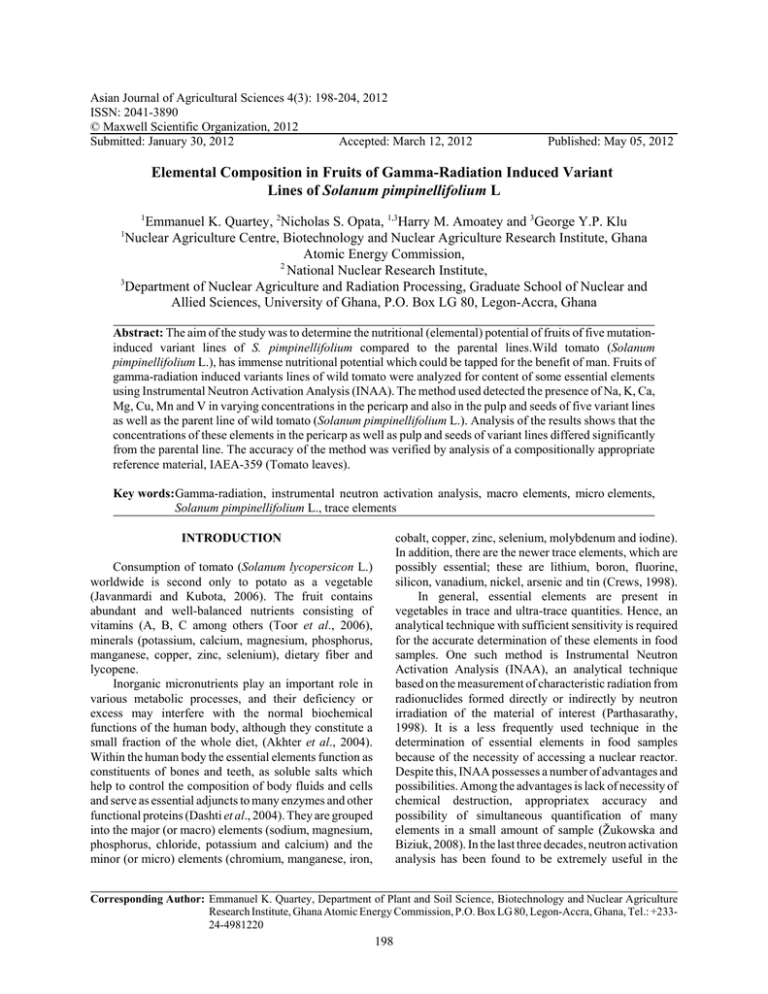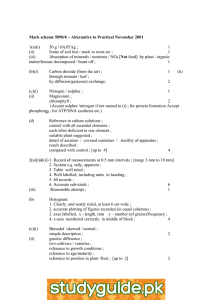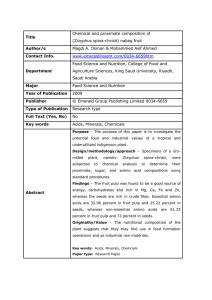Asian Journal of Agricultural Sciences 4(3): 198-204, 2012 ISSN: 2041-3890
advertisement

Asian Journal of Agricultural Sciences 4(3): 198-204, 2012 ISSN: 2041-3890 © Maxwell Scientific Organization, 2012 Submitted: January 30, 2012 Accepted: March 12, 2012 Published: May 05, 2012 Elemental Composition in Fruits of Gamma-Radiation Induced Variant Lines of Solanum pimpinellifolium L 1 Emmanuel K. Quartey, 2Nicholas S. Opata, 1,3Harry M. Amoatey and 3George Y.P. Klu 1 Nuclear Agriculture Centre, Biotechnology and Nuclear Agriculture Research Institute, Ghana Atomic Energy Commission, 2 National Nuclear Research Institute, 3 Department of Nuclear Agriculture and Radiation Processing, Graduate School of Nuclear and Allied Sciences, University of Ghana, P.O. Box LG 80, Legon-Accra, Ghana Abstract: The aim of the study was to determine the nutritional (elemental) potential of fruits of five mutationinduced variant lines of S. pimpinellifolium compared to the parental lines.Wild tomato (Solanum pimpinellifolium L.), has immense nutritional potential which could be tapped for the benefit of man. Fruits of gamma-radiation induced variants lines of wild tomato were analyzed for content of some essential elements using Instrumental Neutron Activation Analysis (INAA). The method used detected the presence of Na, K, Ca, Mg, Cu, Mn and V in varying concentrations in the pericarp and also in the pulp and seeds of five variant lines as well as the parent line of wild tomato (Solanum pimpinellifolium L.). Analysis of the results shows that the concentrations of these elements in the pericarp as well as pulp and seeds of variant lines differed significantly from the parental line. The accuracy of the method was verified by analysis of a compositionally appropriate reference material, IAEA-359 (Tomato leaves). Key words:Gamma-radiation, instrumental neutron activation analysis, macro elements, micro elements, Solanum pimpinellifolium L., trace elements INTRODUCTION cobalt, copper, zinc, selenium, molybdenum and iodine). In addition, there are the newer trace elements, which are possibly essential; these are lithium, boron, fluorine, silicon, vanadium, nickel, arsenic and tin (Crews, 1998). In general, essential elements are present in vegetables in trace and ultra-trace quantities. Hence, an analytical technique with sufficient sensitivity is required for the accurate determination of these elements in food samples. One such method is Instrumental Neutron Activation Analysis (INAA), an analytical technique based on the measurement of characteristic radiation from radionuclides formed directly or indirectly by neutron irradiation of the material of interest (Parthasarathy, 1998). It is a less frequently used technique in the determination of essential elements in food samples because of the necessity of accessing a nuclear reactor. Despite this, INAA possesses a number of advantages and possibilities. Among the advantages is lack of necessity of chemical destruction, appropriatex accuracy and possibility of simultaneous quantification of many elements in a small amount of sample (Žukowska and Biziuk, 2008). In the last three decades, neutron activation analysis has been found to be extremely useful in the Consumption of tomato (Solanum lycopersicon L.) worldwide is second only to potato as a vegetable (Javanmardi and Kubota, 2006). The fruit contains abundant and well-balanced nutrients consisting of vitamins (A, B, C among others (Toor et al., 2006), minerals (potassium, calcium, magnesium, phosphorus, manganese, copper, zinc, selenium), dietary fiber and lycopene. Inorganic micronutrients play an important role in various metabolic processes, and their deficiency or excess may interfere with the normal biochemical functions of the human body, although they constitute a small fraction of the whole diet, (Akhter et al., 2004). Within the human body the essential elements function as constituents of bones and teeth, as soluble salts which help to control the composition of body fluids and cells and serve as essential adjuncts to many enzymes and other functional proteins (Dashti et al., 2004). They are grouped into the major (or macro) elements (sodium, magnesium, phosphorus, chloride, potassium and calcium) and the minor (or micro) elements (chromium, manganese, iron, Corresponding Author: Emmanuel K. Quartey, Department of Plant and Soil Science, Biotechnology and Nuclear Agriculture Research Institute, Ghana Atomic Energy Commission, P.O. Box LG 80, Legon-Accra, Ghana, Tel.: +23324-4981220 198 Asian J. Agric. Sci., 4(3): 198-204, 2012 Table 1: Description of tomato lines used for elemental analysis Tomato sample/line Source Fruit colour Control (Wild tomato) BNARI collection Red BV-27 Variant line Light red BV-40 Variant line Yellowish orange BV-21 Variant line Deep red BV-23 Variant line Red BV-10/27 Variant line Red determination of trace and minor elements in many disciplines. These include environmental analysis applications, nutritional and health related studies, geological as well as material sciences. In an earlier study (Quartey, 2010) five mutationinduced variant lines of the wild tomato (S. pimpinellifolium) were produced with promising fruit characteristics following irradiation at 150, 300 and 450 Gy, respectively. There is the need to analyse the nutritional composition of the fruits of these variants in comparison with the parental line, thereby providing further evidence for advancing these lines in future breeding programs. The objective of the study was to determine the nutritional (elemental) potential of fruits of five-mutation induced variant lines of S. pimpinellifolium for some major, minor as well as the new trace elements. The precision and accuracy of the results were evaluated by analyzing the certified reference material IAEA-359 (Tomato leaves). preserved and in addition facilitates subsequent milling of samples (Hoenig, 2001). Table 1 gives a detailed description of the variant lines and other material from which samples were taken for analysis. Elemental analysis: Preparation of samples for neutron activation: Aliquots (approximately 200 mg) of the lyophilized were weighed into clean polyethylene foils, wrapped with forceps and the foil heat-sealed. Three replicates of each sample were prepared. Three replicate samples of compositionally appropriate reference material, International Atomic Energy Agency, IAEA-359 (tomato leaves) were also prepared. The reference material was used as a standard for gamma spectrum evaluation using the relative method of standardization for neutron activation analysis; and in addition to check the accuracy of the analytical method used. MATERIALS AND METHODS Study area: The study was conducted at the Biotechnology and Nuclear Agriculture Research Centre (GAEC) between January and March 2010. Dried seeds of wild tomato (Solanum pimpinellifolium L.) were acutely irradiated at 150, 300 and 450 Gy using a cobalt60 gamma source. For each dose of irradiation approximately 1000 M1 seedlings were transferred from the nursery to the field for study from which M2 (800) and M3 (500) populations were generated. Selection was done on single plant basis using plant architecture, fruit size and fruit colour. Harvested fruits of five variants in the M3 population along with the control were used for this study. Neutron activation for medium-lived and long-lived radioisotopes: The reference material was ‘sandwiched’ between two aliquots of the same lyophilized homogenate and stacked together as close as possible. This was to ensure that samples and standards were activated under identical and same conditions as possible as any variation could remarkably affect the precision. The stacked samples and standard were then placed in the same polyethylene irradiation vial and irradiated for 1 and 6 h with thermal neutrons at a neutron flux of 5×10¹¹ neutrons cm2 s, at the inner irradiation sites of the Ghana Research Reactor-1 facility, situated at the Ghana Atomic Energy Commission. The Ghana Research Reactor-1 is a 30 kW tank-inpool miniature neutron source reactor (China Institute of Atomic Energy). It uses 90.2% enriched uranium (U235)-Aluminium alloy as fuel. It is cooled and moderated with light water and beryllium acting as reflectors (Akaho and Nyarko, 2002). Measurement of induced activity in sample and standard followed immediately they were ejected from the reactor. At the end of the irradiation, samples and standards were allowed to ‘cool’ to enable non-analyte radioisotopes induced together with radioisotopes of interest and which half-life are shorter than that of the radioisotopes of interest to decay. In addition, to allow the activities induced in the samples to reach acceptable levels for handling (human health), samples were collected 30 min later after irradiation. Sample preparation: Harvested fruits obtained from mutation-induced variant lines of Solanum pimpinellifolium and unirradiated (control) plants of Solanum pimpinellifolium were washed with tap water followed by double-distilled water. The pulps of the fruits were scooped into petri-dishes. The pericarps (skin) were placed in separately labelled Petri-dishes. Samples were categorized into two: those comprising only the pericarp (skin) and those comprising the pulp together with the seeds, in conformity with food preparation habits in Ghana where tomato seeds and pulp are usually extracted from the pericarp and processed separately to ensure a homogenous paste. Samples were frozen at -20ºC and lyophilized (Christ Gamma 1-16) at -30ºC and 0.370 mbar. The lyophilized samples were ground to a fine powder with the aid of a laboratory mortar and pestle. The homogenates obtained were stored in closed polyethylene bottles with screw caps and kept at -20ºC until analysis in order to prevent degradation of the sample. Drying by lyophilisation was used because it ensures that the initial sample texture is 199 Asian J. Agric. Sci., 4(3): 198-204, 2012 Table 2: Nuclear data of radionuclides used for instrumental neutron analysis of minor and trace elements (Filby et al., 1970) Used (-ray Element Reaction Half life energy (MEV) 26 Mg Mg(n, ()27Mg 9.45 min 1014.4 48 Ca(n, ()49Ca 8.7 min 3084.4 Ca 41 K(n, ()42K 12.36 h 1524.7 K 23 Na(n, ()24Na 15.02 h 1368.6; 2754.1 Na 55 Mn(n, ()56Mn 2.58 h 846.7; 1810.7; 2112 Mn 63 Cu Cu(n, ()64Cu 12.70 h 1.35477 51 V(n, ()50V 3.75 min 1434 V RESULTS AND DISCUSSION The technique of NAA applied permitted the detection of only seven elements in lyophilized fruit samples of the parental and variant lines. These were magnesium, calcium, potassium and sodium (major elements); copper and manganese (minor elements); vanadium (trace element). Contents of these elements in fruits of the various lines tested are shown in Fig. 1 to 3. The concentrations of the elements varied depending on the type of tissue used for analysis. Figure 1a shows the magnesium content in fruits of the lines studied. In both types of tissues, the magnesium content ranged between 0.04-0.34 g/kg. In the pericarp, fruits of line BV-10/27 had the highest magnesium content of 0.26 g/kg while fruits of line BV-23 recorded the least magnesium content of 0.04 g/kg. Magnesium content in the pulp and seeds was higher than in the pericarp of the tomato lines tested. In the pulp and seeds, magnesium content was highest in line BV-27 with a value of 0.34 g/kg. Line BV-23 had the lowest magnesium content of 0.12 g/kg. Tomato fruits from the control (unirradiated parental line) recorded magnesium contents of 0.16 and 0.31 g/kg in the pericarp and pulp and seeds respectively. Zaichick (2002) reported a value of 0.16 g/kg in a similar study where the pericarp was tested. Adotey et al. (2009) also reported a similar value of 0.16 g/kg. The values reported by these authors are similar to that reported in this study for magnesium content in the pericarp for most of the lines. Some medicinal plants have also been reported to contain between 0.14-0.23 g/kg of magnesium (Dim et al., 2004; Razic et al., 2003; Serfor-Armah et al., 2002). However, magnesium content in the pulp and seeds exceeded that reported by these authors. Magnesium is an essential element known to be vital for the activity of a number of human enzymes particularly those that are involved with the oxidative phosphorylation (Crow et al., 2005). Its chief function in the body includes bone mineralization, building of proteins, and transmission of nerve impulse and maintenance of teeth (Berdanier, 1994). The Recommended Daily Intake (RDI) for magnesium is 350 mg (Anonymous, 2010c). Hence variant lines BV-27 and BV-21 could be useful in achieving this target when both the pericarp and pulp and seeds are consumed together. Figure 1b shows the concentration of potassium in the fruits of the lines of tomato used in the experiment. The study revealed higher levels of potassium in the pericarp than in the pulp and seeds though these were slight only. Potassium concentrations ranged between 3.26-7.31 g/kg in both tissue types. In the pericarp, fruit samples of lines BV-27 (light red fruits) recorded the highest potassium concentration of 7.31 g/kg while line Neutron activation for short-lived radioisoptes: Shortlived radioisotopes were induced in the samples and standards by irradiating with thermal neutrons for 60 sec in the pneumatic sample transfer facility of the research reactor. Samples and standards were stacked together as close as possible and placed in the same polyethylene irradiation capsule. Measurement of induced activity in samples followed by that of the standard were carried out soon after ejection from the reactor. (-activity measurement of samples and standards: Analysis of induced radioisotopes of interest was performed on a PC-based gamma-ray spectroscopy system. The spectroscopy system consists of a Canberra High Purity Germanium (HPGe) N-type coaxial detector (model GR 2518-7500SL) with a resolution (FWHM) of 1.8 keV relative to the 1332.5 keV (-energy line of 60Co; a relative efficiency of 25%; and a peak-to-Compton ratio of 55. Samples and standards were placed on the High Purity Germanium (HPGe) (-ray detectors and the (activity of the induced radioisotopes measured at the same position and distance from detector. The measurement time for short-lived, medium-livedand long-lived radioisotopes depended on the activity of the induced radionuclide (Table 2). Samples were measured first followed by standards. A plexiglass source support was mounted on the detector in order to ensure easy and reproducible source positioning. The irradiation scheme employed prevented any serious elemental interference. Evaluation of peak area of (-spectrum: The peak areas of the (-spectrum for samples and standards were evaluated using the HPGe semiconductor detector (spectroscopy accumulation software, ORTEC MAESTRO-32. The areas under the peaks were integrated and converted into concentration using the relative method of standardization for neutron activation analysis. Data collection and analysis: The concentrations were calculated on dry weight basis, each concentration being an average of three individual determinations. Data were analyzed using One-way ANOVA with SPSS version 16.0. Microsoft excel was used in the drawing of graphs. 200 Asian J. Agric. Sci., 4(3): 198-204, 2012 Pericarp Pulp+seeds 0.35 7 6 K content (g/kg) 0.15 5 4 3 0.10 2 0.05 1 0 Tomato line Control BV-10/27 BV-23 BV-21 Tomato line (a) (b) Pericarp 0.15 0.10 80 60 40 Tomato line Control BV-10/27 BV-23 BV-21 BV-40 0 BV-27 20 0 Control 0.05 BV-10/27 0.20 100 BV-23 0.25 120 BV-40 Na content (mg/kg) 0.30 Ca content (g/kg) Pericarp Pulp+seeds 140 Pulp+seeds BV-27 0.35 BV-21 BV-40 Control BV-27 0 BV-10/27 0.20 BV-23 0.25 BV-21 0.30 BV-40 mg content (g/kg) Pericarp Pulp+seeds 9 8 BV-27 0.40 Tomato line (c) (d) Fig. 1: Concentration of four macro-elements in pericarp and pulp with seeds of tomato lines: (a) Magnesium (b) Potassium (c) Calcium (d) Sodium. Bars indicate standard error of the mean Pericarp Pulp+seeds Pericarp 25 40 35 Cu content (mg/kg) 30 25 20 15 10 Pulp+seeds 20 15 10 Line (a) BV-10/27 BV-21 BV-40 Control BV-10/27 BV-23 BV-21 BV-40 BV-27 Control line 0 BV-23 5 5 0 BV-27 Mn content (mg/kg) 45 (b) Fig. 2: Concentration of two micro-elements in tomato lines: (a) Manganese (b) Copper. Bars indicate standard error of the mean 201 Asian J. Agric. Sci., 4(3): 198-204, 2012 V content (mg/kg) 0.40 Pericarp Pulp+seeds 0.35 0.30 0.25 0.20 0.15 0.10 0.05 BV-10/27 line BV-23 BV-21 BV-40 BV-27 Control 0 Fig. 3: Concentration of vanadium in tomato lines Bars indicate the standard error of the mean BV-21 (deep red fruits) recorded the lowest potassium content of 3.26 g/kg. In the pulp and seeds, fruits of lines BV-27 (light red fruits) and BV-21 (deep red fruits) recorded the highest and lowest potassium concentrations of 4.80 and 3.35 g/kg respectively. Fruits of line BV-27 however recorded the reverse as the pulp and seeds rather gave concentrations exceeding that in the pericarp. Adotey et al. (2009) reported, in a similar work, that potassium concentrations in marketable tomato varieties ranged from 0.28 to 4.29 g/kg. Concentration values reported in this study are above that reported by Adotey et al. (2009). Zaichick (2002) also reported the concentration of potassium in cultivated tomato (S. lycopersicon) to be 1.55 g/kg. That measured in other medicinal plants is around 1.56 g/kg (Serfor-Armah et al., 2001). Potassium is a macronutrient and a major intracellular cation in the human body. It participates actively in the maintenance of the cardiac rhythm (Martin et al., 1985). Its deficiency causes nerve irritability, cardiac and mental disorder, muscular weakness and paralysis. Potassium also facilitates the transmission of nerve impulses. The RD1 for potassium is 3500 mg which is equivalent to 3.5 g (Anonymous, 2010c). This implies that 100 g of tomatoes (S. lycopersicon) consumed a day would supply less than 300 mg of potassium. Line BV-21 could offer tremendous contribution to attaining the RDI target as 100 g consumption would yield about 700 mg. Calcium content in fruits of the lines is shown in Fig. 1 c. Calcium accumulation was found to be higher in the pericarp than in the pulp and seeds. In both types of tissues used in the experiment, calcium content ranged between 0.04-0.30 g/kg. Calcium concentrations in the pericarp ranged from 0.06 mg/kg in fruits of line BV-27 (light red fruits) to 0.30 mg/kg in line BV-10/27 (red), while calcium content in the pulp and seeds ranged between 0.04 and 0.22 mg/kg, with lines BV-27 (light 202 red) and BV-40 (yellowish orange fruits), recording the lowest and highest calcium content respectively. However, it is worth mentioning that the calcium content of BV-40 was constant in both types of tissues examined. Adotey et al. (2009) reported in their work that calcium ranged between 0.002-0.24 g/kg in market-purchased tomato (S. lycopersicon). Soil nutritional conditions could have influenced the variations. Zaichick (2002) reported the calcium content in some commercial tomatoes to be 0.31 g/kg, which is equivalent to that reported in this study. Calcium acts as the main structural element of bones and teeth in humans. Calcium is also essential for the formation of fibrinogen which is vital for blood clotting. Low calcium intake causes deficiency in the body leading to osteoporosis. Calcium deficiency may also cause rickets in children. The functions of calcium in the human system demand sufficient intake of this mineral (Martin et al., 1985). The RDI for calcium is 1000 mg which is equivalent to 1 g (Anonymous, 2010c). Lines BV-10/27 and BV-23 could be developed to supplement other sources of calcium in achieving this target. Figure 1d shows the concentration of sodium in fruits of lines tested. Sodium content in the pericarp ranged between 77.15 mg/kg in line BV-27 to 108.4 mg/kg in line BV-10/27. Line BV-27 again recorded the lowest sodium content of 102.7 mg/kg in the pulp and seeds while line BV-21 recorded the highest value of 120.6 mg/kg. Sodium content in the seeds and pulp was more than that observed in the pericarp. Significant differences (p#0.05) were observed in sodium content among fruit samples of all lines studied. Sodium concentration in all lines, including the control, was consistently higher in pulp and seeds than in the pericarp. Adotey et al. (2009) reported sodium concentrations in marketed tomatoes to be between 44.20 and 140.00 mg/kg. Zaichick (2002) reported a lower value of 15 mg/kg. All lines studied were within this range. The variations in the content of sodium may be attributed to factors such as the preferential uptake of sodium by these lines as well as their need for them in fruit formation and overall plant development (Adotey et al., 2009). Sodium together with Cl and K are electrolytes that maintain normal fluid balance inside and outside cells and a proper balance of acids and bases in the body. Deficiency of this element may result in muscle cramp and hypertension (Anonymous, 2010d). The RDI for sodium is 2400 mg (Anonymous, 2010d). Lines BV-21, BV-23 and BV-40 contained significant amounts of sodium which could contribute to the overall RDI of sodium. Figure 2 a shows the concentration of manganese in fruits of lines used for this study. Manganese content in the pericarp of the lines ranged from 5.73 to 11.18 mg/kg. Fruits of line BV-27 recorded the highest value while fruits of the variant line BV-10/27 recorded the least. For Asian J. Agric. Sci., 4(3): 198-204, 2012 all lines, manganese content in the pulp together with seeds far exceeded that in the pericarp, ranging from 22.80-39.21 mg/kg. Variant lines BV-23 (light red fruits) and line BV-21 (deep red) recorded the lowest and highest values respectively. Zaichick (2002) reported a value of 0.31 mg/kg in commercially cultivated tomato (S. lycopersicon). Adotey et al. (2009) on the other hand reported values between 27.23-65.10 mg/kg in S. lycopersison. Although fruits of line BV-40 are yellowfleshed, their high manganese content could be attributed to nutrient status of the soil without ruling out the effects of irradiation. The RDI of manganese is 5 mg (Anonymous, 2010b). Variant lines BV-21 could provide about 4.0 mg/100 g of tomato on dry matter basis if consumption of fruits include the pericarp and the pulp and seeds. Appropriate balance and intake of manganese plays a vital role in preserving bone density and thus preventing osteoporosis. It is also noted to play a key role in preventing diabetes, reducing symptoms related to premenstrual syndromes in women and preventing epilepsy (Zhao et al., 2002). Concentration of copper in fruit samples of the lines tested is shown in Fig. 2 b. Copper was found to be a major component of the pericarp in fruits of all lines used for the study. Copper content in the pericarp of the samples ranged from 21.89-8.58 mg/kg, with fruits of the control and line BV-23 recording the highest and lowest values respectively. Fruits of line BV-27 had the lowest copper content in elemental evaluation of the pulp and seeds with a value of 1.54 mg/kg, while fruits of line BV10/27 had the highest copper content of 8.96 mg/kg. None of the lines used recorded copper contents in the pericarp that exceeded that of the control. This could possibly be attributed to the effect of gamma radiation on copper formation in fruits of variant lines as well as nutritional factors. The RDI of copper is 2 mg (Anonymous, 2010c). The control line was adjudged as the best source of the element with a copper concentration of 3.0 mg/ 100 g of tomato on dry matter basis. In the past, not much work had been carried out on copper probably due to the earlier misconception about its insignificance in the diets of people (WHO, 1973). However it is now known that copper protects the human body against oxygen radicals, enhances integrity of bones and lungs and is also a major component of collagen (a prevalent protein found in human skin) and elastin (Copper Development Association, 1984). Figure 3 shows the concentration of vanadium in the fruit samples tested. The concentration of vanadium in the pericarp of the fruits ranged from 0.28-0.02 mg/kg with fruits of line BV-40 and BV-27 recording the highest and the lowest values. Concentration of vanadium in the pulp and seeds exceeded that in the pericarp in fruits of the control, BV-27 and BV-40. The reverse was the case in the variants BV-21 and BV-23. In the variant BV-10/27 the element Vanadium was present in approximately equal proportions in the pericarp as well as the pulp and seeds. The lowest vanadium content in the pulp and seeds was 0.04 mg/kg, recorded by fruits of variant line BV-27. Fruit samples of line BV-40 (yellowish orange) recorded the highest amount of vanadium in the pulp and seeds with a value of 0.35 mg/kg. This study has shown that vanadium tends to be accumulated in the pulp and seeds of tomato. The RDI for vanadium is 1.8 mg (Anonymous, 2010a). With vanadium content of 0.03 mg/100 g of tomato on dry weight basis, fruits of line BV-40 could significantly contribute to meeting this nutritional target. The presence of vanadium in the brain inhibits cholesterol from forming in the blood vessels (Takeda, 2003). Vanadium also plays a role in cellular metabolism, the formation of bones and teeth, reproduction and growth (Martin et al., 1985). CONCLUSION Inorganic nutrients play a major role in ensuring the normal biochemical function of the body, although they constitute a small fraction of the whole diet. These elements have been found to be present in various parts of the tomato fruit. In this experiment, mutation induction has been noted to generate variability in the availability of these inorganic micronutrients in fruits of five mutationinduced variant lines of S. pimpinellifolium. Calcium and potassium were more highly concentrated in the pericarp than in the pulp and seeds. On the other hand, manganese and vanadium were more concentrated in the pulp and seeds than in the pericarp. These findings underscore the need to add the seeds and pulp in the grinding process as they contain substantial amounts of essential elements. ACKNOWLEDGMENT The authors would like to thank the Government of Ghana through the Ghana Atomic Energy Commission for providing financial assistance. Gratitude also goes to technical staff of the Ghana Research Reactor-1 facility for their assistance. REFERENCES Adotey, D.K., Y. Serfor-Armah, J.R. Fianko and P.O. Yeboah, 2009. Essential elements content in core vegetables grown and consumed in Ghana by instrumental neutron activation analysis. Afr. J. Food Sci., 3(9): 243-249. Akaho, E.H.K. and B.J.B. Nyarko, 2002. Characterization of neutron flux spectra in irradiation channel of MNSR reactor, using Westcottformalism for k0 neutron activation analysis method. Appl. Radiat. Isotopes, 57: 265-273. 203 Asian J. Agric. Sci., 4(3): 198-204, 2012 Martin Jr., D.W., P.A. Mayers, V.W. Rodwell and D.K. Granner, 1985. Harper’s Review of Biochemistry. 20th Edn., Lange Medical Publications, California, pp: 651-660. Parthasarathy, R., 1998. Enhancement of Research Reactor utilization for Neutron Activation Analysis. In: Use of Research Reactors for Neutron Activation Analysis, Report of an Advisory Group Meeting, 1226 June, 1998, Vienna, Austria, pp: 57-69. Quartey, E.K., 2010. Efforts towards domestication of wild tomato (Solanumpimpinellifolium L.) using mutation and in vitro culture techniques. M.Phil Thesis, University of Ghana, Legon. Serfor-Armah, Y., B.J.B. Nyarko, E.H.K. Akaho, A.W.K. Kyere, S. Osae, K. Oppong-Boachie and E.K.J. Osae, 2001. Activation analysis of some essential elements in five medicinal plants used in Ghana. J. Radioanal. Nucl. Chem., 250(1): 173-176. Serfor-Armah, Y., B.J.B. Nyarko, E.H.K. Akaho, A.W.K. Kyere, S. Osae and K. Oppong-Boachie, 2002. Multielemental analysis of some traditional plant medicines used in Ghana. J. Trace Microprobe Tech., 20(3): 419-427. Razic, S., A. Onjia and B. Potkonjak, 2003. Trace elements analysis of Echinaceapurpurea-herbal medicinal. J. Pharmacent. Biomed. Anal., 33: 845-850. Takeda, A., 2003. Manganese action in brain function. Brain Res. Rev., 41(1): 79-87 Toor, R.K., G.P. Savage and C.E. Lister, 2006. Seasonal variations in the anti-oxidant composition of greenhouse-grown tomatoes. J. Food Compos. Anal., 19(1): 1-10. World Health Organization (WHO), 1973. Copper: In Trace Elements in Human Nutrition. Technical Report Series No. 532, WHO, Geneva, pp: 2-3. Zaichick, V., 2002. Instrumental neutron activation analysis of minor and trace elements in food in the Russian region that suffered from the Chernobyl disaster. Food Nutr. Bull., 23(3): 191-194. Zhao, Y., T.D. Oberley, L. Chaiswing, S.M. Lin, C.J. Epstein, T.T. Huang and D. Clair, 2002. Manganese superoxide dismutase deficiency enhances cell turnover via tumor promoter-induced alterations in Ap-1 and P53-mediated pathways in a skin cancer model. Oncogene, 21(24): 3836-3846. Žukowska, J. and M. Biziuk, 2008. Methodological Evaluation of Method for Dietary Heavy Metal Intake. J. Food Sci.,s 72(2): 21-29. Akhter, P., K. Ur-Rehman, S.D. Orfi and N. Ahmad, 2004. Assessment of Iodine levels in the Pakistani diet. Nutri., 20: 783-787. Anonymous, 2010a. Retrieved from: http://www.acucell.com/vmo.html, (Accessed on: April 1, 2010). Anonymous, 2010b. Retrieved from: http://www. epa.gov/ttn/atw/hlthef/manganes.html, (Accessed on: April 10, 2010). Anonymous, 2010c. Retrieved from: http://www. lenntech.com/recommended-daily-intake.html, (Accessed on: April 26, 2010). Anonymous, 2010d. Retrieved from: http://www. mayoclinic.com/health/sodium/nu00284, (Accessed on: April 26, 2010). Berdanier, C.D., 1994. Advanced NutritionMicronutrients. CRC Press, New York, pp: 23. Copper Development Association, 1984. Copper and human health-A review. Technical Note, 34: 2-12. Crews, H.M., 1998. Speciation of trace elements in foods, with special reference to cadmium and selenium: Is it necessary? Spectrochmica Acta. Part B., 53: 213-219. Crow, J.P., N. Y. Calingasan, J. Chen, J.L. Hill and M.F. Beal, 2005. Manganese porphyrin given at symptom onset markedly extends survival of ALS mice. Ann. Neurol., 58(2): 258-265. Dashti, B., F. Al-Awadi, R. AlKandari, A. Ali and J. AlOtaibi, 2004. Macro-and microelements contents of 32 Kuwaiti composite dishes. Food Chem., 85: 331-337 Dim, I.A., I.I. Funtua, A.O. Oyewale, F. Grass, I.M. Umar, R. Gwozdz and U.S. Gwarzo, 2004. Determination of some elements in Ageratum conyziodes, a tropical medicinal plant, using instrumental neutron activation analysis. J. Radioanal. Nucl. Chem., 261(1): 225-228. Filby, R.H., A.I. Davis, K.R. Shah, G.G. Wainscott, W.A. Haller and W.A. Cassat, 1970. Gamma Ray Energy Tables for Neutron Activation Analysis, Washington State University Technical Bulletin. pp: 23-35. Hoenig, M., 2001. Preparation steps in environmental trace element analysis-facts and traps. Talanta, 54: 1021-1038. Javanmardi, J. and C. Kubota, 2006. Variation of lycopene, antioxidant activity, total soluble solids and weight loss of tomato during postharvest storage. Postharvest Biol. and Tec., 41(2): 151-155. 204





